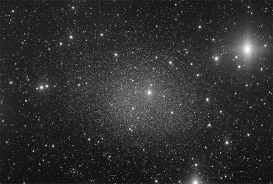This is an old revision of the document!
Table of Contents
Spherical & Triaxial
 These mock data are designed to mimic spherical/triaxial collisionless stellar systems (e.g. dwarf galaxies and giant elliptical galaxies). Key questions include:
These mock data are designed to mimic spherical/triaxial collisionless stellar systems (e.g. dwarf galaxies and giant elliptical galaxies). Key questions include:
(1) What quality of data are required to determine the mass profile? (2) How can we best break the degeneracy between velocity anisotropy and mass? (3) How badly do we do if we assume spherical symmetry but the galaxy is actually triaxial?
Key working group coordinator: Justin Read
The default mock data suite
The default mocks are designed to cover the following tests:
-
- Cusped and cored
- Isotropic; Osipkov Merritt; Tangential anisotropy
- Plummer light; cuspy light
- Sampling: 10^2, 10^3, 10^4
- Split population: Perfect (wide scale length sep); Sampled
- Measurement error
- Contamination (binaries, foreground)
The default outputs
- Cumulative mass profile with 68%/95% confidence intervals (i.e. 1 and 2-sigma equivalent) and median of the distribution
- Density versus radius (with confidence intervals as above)
- <latex>$d\ln\rho/d\ln r$</latex> (with confidence intervals as above)
- Anisotropy profile (with confidence intervals as above); <latex>$\beta® = 1 - \sigma_\theta^2/\sigma_r^2$</latex>
- Projected light number density profile with conf. intervals (+data overlay)
- Projected velocity dispersion profile with conf. intervals (+data overlay)
Example: Units: kpc, Msun, km/s File format: ASCII columnated (headings allowed). Example:
| Height (kpc) | Cumulative mass (Msun) [45.7% low] | 34% low | Median | 34% high | 47.5% high |
|---|---|---|---|---|---|
| 0.2 | 1e4 | 5e4 | 10e4 | 15e4 | 20e4 |
Publication policy
If using the spherical test data, please cite the Gaia Challenge wiki and http://adsabs.harvard.edu/abs/2011ApJ...742...20W. For further details of our publication policy see publications.
If using the triaxial test data, please cite the Gaia Challenge wiki and http://adsabs.harvard.edu/abs/2009MNRAS.395.1079D, as the data for this test were generated using the Made-to-Measure (M2M) N-body code from Dehnen 2009. For further details of our publication policy see publications.
Results
Results from running the above using a variety of techniques can be found here.
